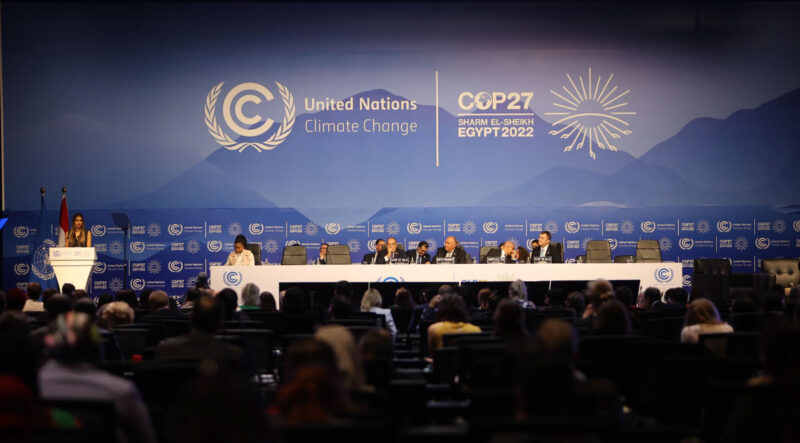Aquaculture takes centre stage at UN climate conference
Improving aquaculture will give us more affordable protein for less environmental impact says world’s largest conservation organization, as COP 27 climate conference gets underway in Egypt
By Fabian Dawson
SeaWestNews
There is no prospect of maintaining the sustainability of the international seafood sector without shifting large amounts of fish production to aquaculture, says WWF, the world’s leading conservation organization.
“We have now turned the corner that we have to farm the ocean to get the protein that we need,” says Merrielle Macleod, a director on the WWF-US Aquaculture team, as world leaders gathered in Egypt for this year’s UN Climate Conference (COP27).
“There’s a lot of evidence that the footprint of aquaculture makes it a lower impact way for people to eat.” Macleod said, according to TheFishSite.
Emphasising that any type of food production, including aquaculture, has an impact on the environment, she said the essential goal is to use fish farming to produce protein for the world’s people with less environmental impact than other forms of protein production.
“It’s not as useful to think of a farmed fish versus a wild-caught fish. In the global context, it may be more useful to compare farmed fish to a farmed chicken or cow.
This lens, she said, can help consumers understand that many of the negatives associated with aquaculture, are part of the elements of this production system’s footprint.
“The question is not whether those elements are harmful, but instead what is the relative harm of the aquaculture production footprint to other systems’ footprints, such as overfishing in wild-caught seafood or methane production in cattle ranching?”
Current estimates also show ocean-based salmon farms emit only 2.2 kilograms of carbon dioxide for every kilogram of edible fish produced. That is less than half of any animal raised on land, including 5.1 kilograms of CO2 per kilogram of chicken, 6.4 kilograms for pork, and 37.2 kilograms for beef.
Ian Roberts, chair of the Canadian Aquaculture Industry Alliance (CAIA) said ENGOs like the WWF and the Nature Conservancy – those working for real and lasting improvements in environmental performance but also recognizing the need to balance priorities and ensure economic development – have increasingly seen aquaculture as a solution to climate change.
“More social and environmental interest groups need to look at aquaculture with a fresh set of eyes, recognize the massive improvements made in the last ten years alone, and work with the sector to continue to improve it,” he told SeaWestNews.
Roberts, who is Mowi’s director of communications for Scotland, Ireland and Canada, said a major challenge for Canada is to integrate discussions about food and climate.
“Seafood and aquaculture have historically been overlooked, as Canada’s Department of Fisheries and Oceans (DFO) is a regulator but not a proponent and not at the table of these important global discussions,” he told SeaWestNews.
“Agriculture and Agri-Food Canada, as the lead Food department, should be formally tasked with including seafood in its international work, including climate change,” he said, adding governments also need to look at aquaculture in all its forms with a fresh perspective.
He pointed out that The High Level Panel for a Sustainable Oceans Economy, study on“Food from the Ocean” has found that largely through aquaculture we can sustainably produce six times the amount of food from the oceans than we do at present.
“Canada has a massive – perhaps globally unprecedented – opportunity to grow its aquaculture sector.”
The WWF’s web-based carbon calculator shows that if Canadians – who eat very little seafood on average, making up only 1.6% of the total diet – were to simply double their seafood intake – it would reduce GHG emissions in Canada by 3 million tonnes (MT), the equivalent of taking close to 650,000 cars off Canadian roads.
“And this is all through ocean farming that uses the natural energy from the oceans,” said Roberts.
According to FAO’s latest data, an estimated 58.5 million people were employed in the sector and of these approximately 21 percent were women. Around 600 million people are estimated to depend on fisheries and aquaculture in some way for their lives and livelihoods.
In Canada, aquaculture represents about a third of the country’s total fisheries value and about 20% of total seafood production. The value of aquaculture production has increased by 63% over the last ten years, to $962 million in 2013 from $591 million in 2003. In fact, Canadian production has increased four-fold since the early nineties.
Canada is the fourth-largest producer of farmed salmon in the world with 97 per cent of salmon produced in Canada being farm-raised, which is key to reducing pressure on limited wild stocks.
Aquaculture employs about 14,000 in full-time, well-paying jobs that are primarily located in smaller coastal and rural communities. Canada’s farmed-salmon industry provides more than 10,000 jobs alone, the majority of which are in coastal areas of British Columbia and New Brunswick.
The aquaculture industry also generates a little more than half a billion dollars in labour income.
The United States, recognising the urgent need to increase seafood production in its waters, recently unveiled a 5-Year Strategic Plan for Aquaculture.
Currently, China is the biggest producer of aquaculture products in the world, with around 62% of the world’s fish and shellfish.(
Over 45,000 people from 196 countries, including 120 heads of state, are gathering in the city of Sharm El-Sheikh in Egypt at the 27th iteration of the Conference of Parties to the UN Framework Convention on Climate Change, or COP27. – photo courtesy


Comments are closed.